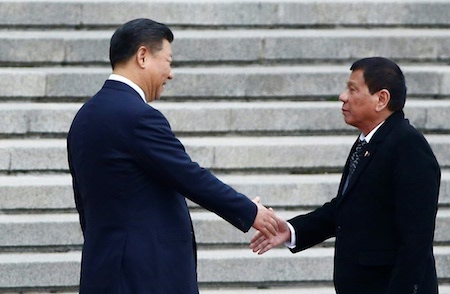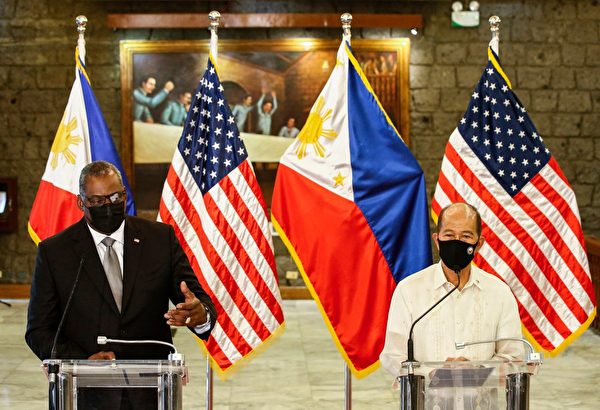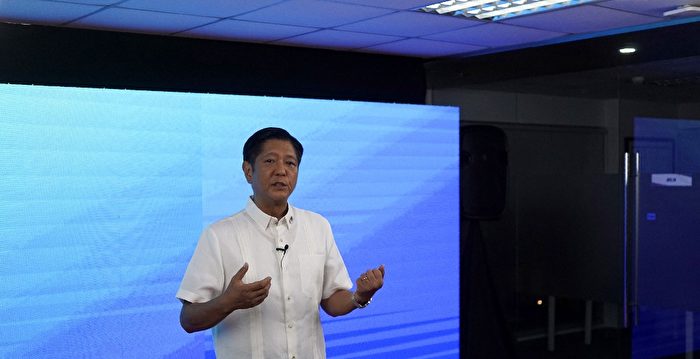[Epoch Times, May 16, 2022](Epoch Times reporter Song Tang comprehensive report) On May 12, the “US-ASEAN Summit” was held in Washington, and ASEAN leaders gathered at the White House for the first time. Meanwhile, Ferdinand Marcos Jr, the son of former President Marcos, who won a landslide presidential election, will take office at the end of June for a six-year term if the election results are valid.
The election of Marcos sparked a wrestling between the United States and China for the Philippines. The Philippines is an island country facing the sea. It is located at the southern end of the first island chain, with Taiwan to the north and the South China Sea, the world‘s busiest commercial transportation line, to the west. The Philippine Sea in the east is located between the first island chain and the second island chain. The only way for ships to enter and exit the Pacific Ocean is a very important strategic position.
After Marcos won the election, the US and Chinese heads of state all congratulated him and expressed their vision to strengthen bilateral relations.
Over the past few decades, the US military presence in the Western Pacific has maintained the stability and peaceful development of Southeast Asia. As the CCP penetrates overseas, its economic tentacles gradually extend to Southeast Asian countries. The United States launched the “Asia-Pacific Economic Framework”, but the “Asia-Pacific Economic Framework” is not a trade agreement and may only provide a channel for dialogue.
To make up for this shortcoming, U.S. President Joe Biden will visit South Korea and Japan over the weekend. Japan’s ambassador to the United States said on May 9 that during Biden’s visit, the new US Indo-Pacific economic strategy is expected to be officially launched at the same time.
Southeast Asia is one of the main battlegrounds of the US-China rivalry. All countries in the region are facing the economic penetration of the Chinese Communist Party. At the same time, all countries rely on the United States for security, and the Philippines is no exception.
However, given that the Philippines and the United States are traditional allies with similar languages and religions, the Philippine people have frequent exchanges with the United States, and the military is a firm ally of the United States, and the Philippines trusts the United States more. Therefore, although the Philippines is economically dependent on Beijing, it is reluctant to engage in a head-on conflict with the CCP over the South China Sea issue. However, the Filipino people are extremely politically sensitive to China as an economic partner, resist the security threat brought by the Belt and Road Initiative to the Philippines, and cancel many large-scale Belt and Road projects.
Taking President Duterte as an example, although he criticized the United States in the early stage, abolished the “Visiting Forces Agreement”, issued pro-Beijing remarks, and vigorously promoted the “Belt and Road”, but later returned to the “Visiting Forces Agreement” and the “Belt and Road”. Due to domestic pressure, many projects could not be implemented.
What position will the new Philippine president take on Beijing?
What worries the outside world is that Marcos may have a pro-Beijing tendency based on his personal experience. At the age of 18, Marcos accompanied his mother Imelda to visit Beijing, and declassified documents show that Marcos “frequently traveled to China in 2005 and 2006 in order to attract business.” In 1986, the United States supported the overthrow of the authoritarian rule of Marcos’ father. In 2011, the U.S. District Court in Hawaii found Marcos and his mother contempt of court and imposed a fine of $353 million. For this reason, Marcos has been 15 years old. I didn’t dare to go to America.

However, Victor Manhit, head of consulting firm BowerGroupAsia, believes that Marcos is very different from Duterte. “Duterte is the mayor of a small city. A mayor who has become president. Marcos grew up more cosmopolitan and has a better understanding of what’s going on around the world.”
“When he started the campaign, Marcos initially took a reassuring stance against Beijing,” Manhit told CNBC. But as he entered the campaign stage, he was able to listen to the voices of the Filipino people, who were worried about Chinese aggression. Philippine behavior.”
Manhit believes that Marcos’ awareness of the Philippines’ place in the world could drive policy in the exact opposite direction of Duterte’s.
Gregory Poling, a senior fellow at the Center for Strategic and International Studies (CSIS), wrote, “The Philippines tried to extend a friendly hand, and China (the CCP) bit back. This is why in the past two In 2018, the Duterte administration re-embraced the U.S., its ally, and made it tougher on Beijing. The Filipino people and government institutions distrust China even more than after the victory in the South China Sea arbitration six years ago.”
“Marcos may try to restore Duterte’s early ties to Beijing, but he is unlikely to abandon the United States as an ally,” Pollin said.
Frank Thiel, president of the American Chamber of Commerce in the Philippines, believes that on trade, a Marcos presidency could mean a free trade agreement between the United States and the Philippines is back on the agenda.
Philippines engages China economically but wary of China
The Philippines has engaged with China mainly for economic purposes. According to statistics from the Philippine Department of Trade and Industry, the total trade volume between China and the Philippines in 2021 will reach US$38.34 billion, and China will remain the Philippines’ largest trading partner, largest source of imports, and second largest export market.
After the Duterte government came to power, in order to create employment opportunities and reduce poverty, it proposed the “Build BuildBuild” plan to promote the “Belt and Road” project. But the Filipino people are sensitive to China as an economic partner, and many large-scale Belt and Road projects have been cancelled.
Like Duterte, Marcos faces warnings from economists in seeking Chinese investment: The CCP will impose harsh conditions on loan interest rates, labor, technology and raw materials, and Chinese projects will also involve national security. Under the pressure of domestic and foreign politics, there is a risk of stagnation or a deal not coming to fruition.
For example, in 2018, the largest shipyard in the Philippines, “Hanjin Subic Shipyard”, filed for bankruptcy due to arrears of about US$400 million in loans. Chinese companies are interested in buying the shipyard, but there are concerns and opposition from the public because Subic Bay, where the shipyard is located, is an important geopolitical hub.
In addition, former U.S. President Donald Trump’s trade war with China has forced Philippine major telecom giant Globe Telecom to avoid using Huawei equipment to reduce supply chain risks.

During Xi’s 2018 visit to the Philippines, he signed a deal for a project called “Secure the Philippines” to install 12,000 sets of CCTV surveillance cameras in the Philippines, but the project could allow China to spy on the Philippines and was blocked in Congress.
Another example is the “Belt and Road Initiative” Philippine infrastructure project Sangley Point International Airport, because the construction of the China Communications Construction Company sanctioned by the United States and built islands in the South China Sea, the local provincial government announced the cancellation of the project in early 2021 contract.
On the other hand, many of China’s “One Belt, One Road” projects have irregularities, including economic debt traps, unsustainable debt, not using local labor, and China (the CCP) only pays attention to dealing with upper-level officials in the government , ignoring popular responses and lack of consultation with affected stakeholders.
For example, the Kaliwa Dam in the Philippines, which was built by China, will “permanently and irreversibly change the ecological environment of the region” after the dam is completed.
With geopolitical competition looming, the Philippine legislature in particular is more critical of China. For example, in a proposed amendment to the Public Service Act, foreign state-owned enterprises would be prohibited from owning capital in critical infrastructure in the Philippines.
Filipinos and the military trust the U.S. more
Unlike Laos and Cambodia, which have been most affected by the CCP, and also different from other Southeast Asian countries, the Philippines has been influenced by the West for a long time. Spain and the United States have left Catholicism and English respectively. About 90% of the residents of the Philippines are Christians. It is also the country with the largest number of English speakers in Asia.
The United States and the Philippines share strong historical and cultural ties, shared values, frequent people-to-people exchanges, and people-to-people exchange programs between the United States and the Philippines, including the world‘s longest-running Fulbright Program, International Visitor Leadership the International Visitor Leadership Program and the Kenney-Lugar Youth Exchange and Study program.
According to the U.S. State Department webpage, there are more than 4 million Filipino Americans living in the United States and nearly 300,000 American citizens living in the Philippines, including a large number of American veterans. Before the COVID-19 outbreak, more than 1 million U.S. citizens visited the Philippines each year. The United States and the Philippines have a strong trade and investment relationship, with trade in goods and services exceeding $18.9 billion during 2020. The United States is also the Philippines’ third largest trading partner and one of the largest foreign investors.
In 2020, the Social Weather Observatory (SWS), a Philippine polling agency, released a survey showing that despite President Duterte’s pro-Beijing rhetoric, Filipinos’ trust in China (CCP) index has risen from “poor” to “poor”. ) fell to “bad” with a net trust index of minus 36, down nine points from the December 2019 net trust index of minus 27.
Since August 1994, the index of net trust in China has been positive only 9 times out of 53 surveys. In September 2015, its worst recorded net trust index was negative 46.
Contrary to China, the US has consistently shown positive net trust in 68 surveys since the first survey in December 1994: as low as “moderate” +18 in May 2005, as high as 2013 “excellent” +82 for December. The U.S. dropped from “very good” +67 in December 2019 to “good” +42 in July 2020.
In particular, the United States and the Philippines are long-term military and security strategic allies. The two countries signed the Mutual Defense Treaty as early as 1951. The Visiting Forces Agreement is another important military cooperation agreement between the United States and the Philippines. As an ally of the United States, the Philippine government receives at least $100 million in military aid a year. The United States provided at least $500 million in military aid to the Philippines from 2016 to 2019.
The United States-Philippines Shared Vision for Partnership in the 21st Century, released in November 2021, reiterates: “We remain intent on strengthening the defense capabilities of the Armed Forces of the Philippines, especially in light of the current geopolitical tensions, especially in the Philippines. Ocean Region, … and assure each other that the alliance is strong and will remain for decades to come.”
During a visit to the Philippines by U.S. Secretary of Defense Austin last July, Duterte permanently reversed his decision to terminate the U.S.-Philippines Visiting Forces Agreement and reinstated it.

In March and April this year, more than 5,000 U.S. and Filipino amphibious landing exercises of the “Balikatan” joint military exercise were the largest in seven years. For the first time this year, the Patriot missile system was included in the exercise and deployed. In Cagayan Province, just over 300 kilometers away from Taiwan. The deployment has drawn attention amid rising tensions across the Taiwan Strait.
Renato Cruz De Castro of Manila’s De la Salle university told Reuters, “Duterte realizes that whether you appease or challenge China (CCP), it doesn’t matter. They (CCP) will still try to take your territorial waters.”
“Marcos may have some issues with the U.S., but he will be conditioned by his government agencies and the military, which really value the U.S.-Philippine alliance,” de Castro said.
Responsible editor: Lin Yan#
